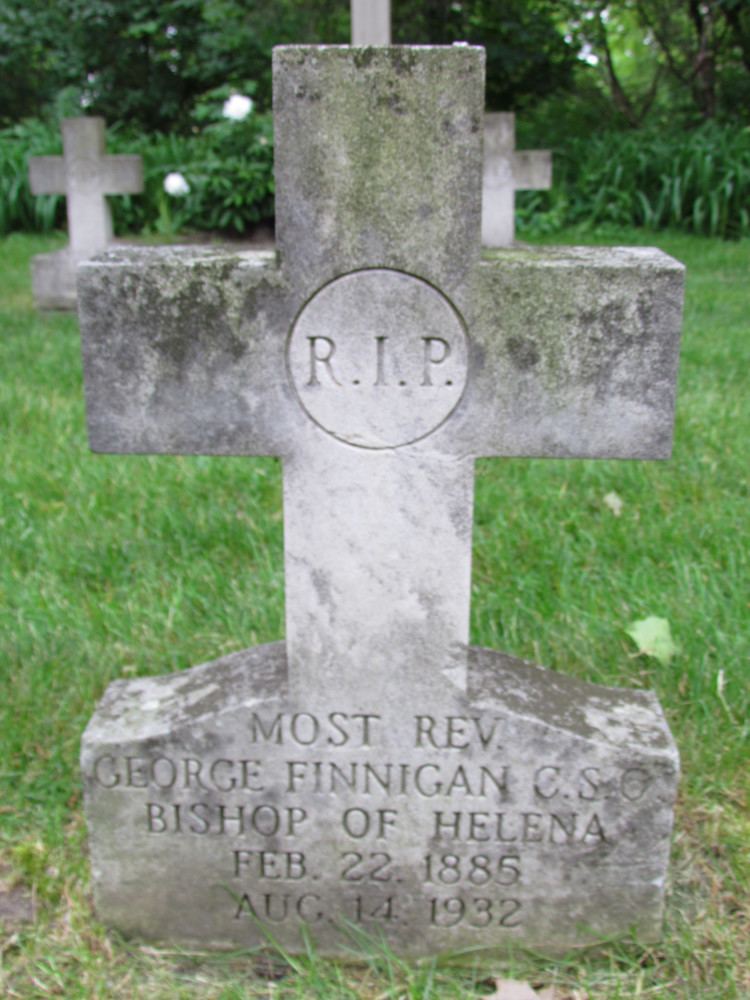Province Province of Portland Nationality American Ordination June 13, 1915 | Installed August 18, 1927 Name George Finnigan Consecration August 1, 1927 Term ended August 14, 1932 | |
 | ||
Born February 22, 1885Potsdam, New York ( 1885-02-22 ) Place of burial Notre Dame, Indiana, United States | ||
George Joseph Finnigan, C.S.C. (February 22, 1885 – August 14, 1932) was a 20th-century bishop in the Catholic Church in the United States.
Contents
Biography
Born in Potsdam, New York Finnigan professed religious vows in the Congregation of Holy Cross and was ordained a Catholic priest on June 13, 1915. Pope Pius XI named him to be the third bishop of the Diocese of Helena.in the state of Montana. He was consecrated a bishop on August 1, 1927 by Archbishop Peter Joseph Hurth C.S.C., who was Titular Archbishop of Bostra and Bishop of Nueva Segovia in the Philippines. The co-consecrators were Bishops John F. Noll of Fort Wayne and Edward Francis Hoban, Auxiliary bishop of Chicago. He was installed in Helena on August 18, 1927 and served the diocese for five years until his death in 1932.
Formation as a priest
Finnigan earned a bachelor's degree from the University of Notre Dame in 1910, before being sent to study at Holy Cross Seminary. In Rome, he earned a Licentiate of Sacred Theology at the Pontifical Gregorian University. Later, he earned a Doctor of Sacred Theology at the Laval University in Montreal.
Ministry as priest
As a priest, Finnigan served at the University of Notre Dame. Along with Holy Cross Fathers Ernest Davis, Edward J. Finnigan, Frederick T. McKeon, James J. O'Brien, Charles L. O'Donnell, and Matthew J. Walsh, Finnigan served as a military chaplain in World War I. None of the Holy Cross Fathers lost their lives in the conflict. Finnigan served as chaplain of the local 137th Field Artillery Regiment, stationed at Fort Shelby, Hattiesburg, Miss. Later, serving in France, he was a chaplain with the 80th Field Artillery, earning the rank of captain.
In 1925 Finnigan was appointed Vice President at the University of Notre Dame. Father Finigan's period as vice president coincided with the ascent of Notre Dame football, and, to counter accusations of academic laxness, he created the university's Athletic Board of Control and issued the first rules governing academic and personal standards for amateur athletes. His ascent continued when he was elected Provincial of the U.S. Province of the Congregation of Holy Cross the following year for a six-year term, truncated when the Pope appointed Finnigan to be Bishop of Helena in 1927. The remainder of his term was completed by Fr. James A. Burns, C.S.C.
Ministry in the Diocese of Helena
While several members of the Congregation of Holy Cross had been named to the episcopacy, Bishop Finnigan was the first to do so as a bishop in the United States. During his five years as bishop, he worked "to win the understanding and the cooperation of the clergy and of the people; to establish means of encouraging and financing native vocations to the priesthood; and to improve the condition of the Native Americans entrusted to his care. These were the guidelines this quiet, unassuming prelate followed."
During his time of service, the members of Blackfoot Confederacy adopted Bishop Finnigan into the tribe in Browning, Montana on April 22, 1928. Mountain Chief gave Bishop Finnigan the name "Na-toa-ye-owa-shin" which means "Holy Word." He worked on behalf of Native Americans both with appeals for money to upgrade their churches, schools and infrastructure, and through prayer.
Bishop Finigan's ministry also, of necessity, responded to the impact of the Wall Street Crash of 1929. The Crash, combined with a severe drought in Montana, obliged the diocese to increase its care for the poor. Bishop Finnigan led efforts to care for those most harmed by the effects.
Bishop Finnigan, with his experience in higher education, devoted substantial resources and efforts to getting accreditation and long-term financial support for Mount St. Charles College. At commencement in 1932, Bishop Finnigan announced that the college would assume a new name in honor of its founder and the diocese's second bishop: Carroll College.
